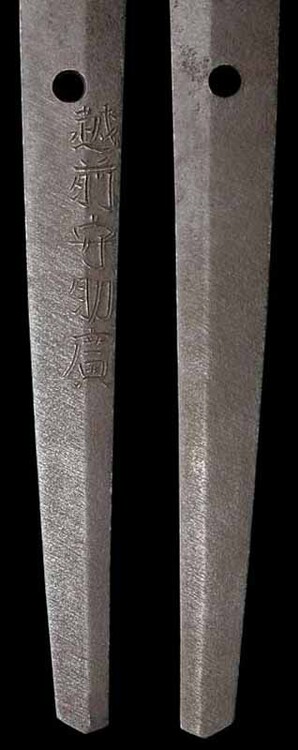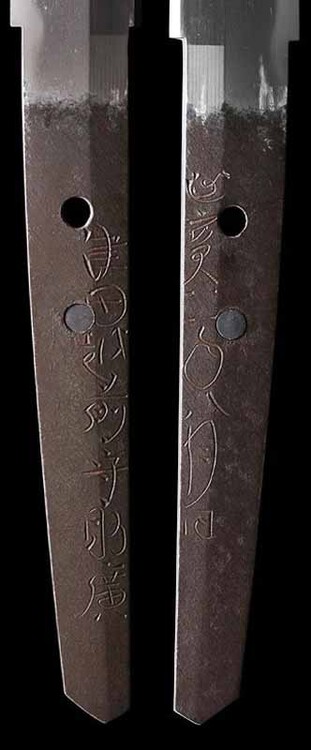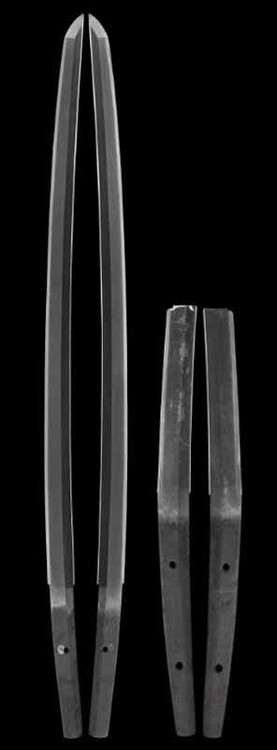-
Posts
1,029 -
Joined
-
Last visited
Everything posted by Eric H
-
Bichu Kuni Suiden Ju Kunishige Eric
-

Announcement of New Swordsmith Index
Eric H replied to Markus's topic in General Nihonto Related Discussion
Markus, A German retailer offers this lexicon for € 260.00. Can it also be ordered directly from you? Eric -
SHINGANE... The smith will choose the best pieces of tamahagane when preparing the material for kawagane. Eric
-
There is a theory that in Koto times the Tatara operation resulted in low quality tamahagane and it depended entirely on the swordsmiths skill to manage that material to make a sword of high quality, but time consuming. This is in full accordance with the maru-gitae technique formerly specified by Chris B. and Adam L., proven with the sectioned micrograph from a blade by Rai Kunitoshi (there are nenki from 1289-1321). One historical record states that advanced steelmaking processes were employed on a large scale beginning in the Oei era (1394-1428) allowing an increased production of swords. During the late Muromachi period, older methods of swordmaking (maru-gitae?) were abandoned and at the same time new methods of sword making were invented, such as ko-buse and makuri. But why? It is said, that after the Muromachi period a great progress in the manufacture of iron was accomplished, and the smith‘s were able to produce high quality steel. Shinto smiths profited by the improvements in the transportation system having a better access to steel of consistently high quality. It is also said, that a hard type of tamahagane, mass produced, appeared in Keicho (1596-1615). It is perhaps this heightening of the quality of tamahagane, and supposedly at the same time increasing cost of this higher quality tamahagane, that the methods of ko-buse and makuri and other lamination techniques were favored. Interestingliy Suishinshi Masahide initiated a move back to a revival of Koto like swords...did this include the forging in maru-gitae? Naotane has been mentioned. 1) yes 2) ambivalent 3) I think yes 4) Swords have been tested in Shinto and Shinshinto time by experienced swordsmen. I refer to the list by Yamada Asaemon and others. Koto swords were tested, if at all rarely, their effectiveness, perhaps superiority, in combat has been taken as proven. Eric
-
I believe „the unprecented sword forging method“ has nothing to do with any specific lamination method but with the development to harden at higher temperature. It seems that the combination of soft and hard materials was practised before Masamune and such examples are seen in the works of Ko-Bizen and Shoso-in swords too. Though, Masamune employed that forging method and tried to emphasise the conspicuous hataraki of nie intentionally. Hamon in nie-deki is tempered at higher temperature than in nioi-deki and Masamune expresses the most exquisite sword forging technique in nie-deki. (Dr. Honma Junji) Eric
-
Lance, It is just inverse as you have commented, the higher sharpness O-Wazamono is attested to the swords with square style mei, Kaku-Tsuda. It is reasonable to think, that Yamada Asaemon had tested multiple swords of both types, Kaku-Tsuda and Maru-Tsuda to get his judging. Chris Bowens comment on Tsuda Sukehiro and the assumption, that Sukehiro had made swords from single steel aside those with laminated steel, and John Stuart‘s comment on differential hardening, was the motif to point to this discrepancy in the blades of Sukehiro Eric
-
Do we talk on Soshu kitae as a modern invention?...NO You deny Dr. Stein‘s statement on Masamune‘s forging technique...well nobody stops you to have your own opinion. Unfortunately you have absolute no evidence to present facts in favour of your theories...but you insist that others have to prove... Dr. Junji Honma wrote in „Nihon Koto Shi“ No. 12 Masamune appeared at the end of the Kamakura Period and became the founder of Soshu-den that was an unprecented sword forging method. Is it the seven layer construction method? I‘m sure Dr. Stein can enlighten us assumed he will to do so. Eric
-
Page 39 is a listing of Wazamono? Tsuda Sukehiro is a very interesting example in an other aspect, namely the different judging of his blades when performed tameshigiri. According to the „Token no Wazamono Ichiran“ by Yamada Asaemon, Tsuda Sukehiro is listed under Owazamono with swords bearing his mei in „square style“, whilst his swords with mei chiseled in „Sosho“ style are in the group of Wazamono sharpness. First generation Sukehiro -Soboro Sukehiro- is ranked Saijo Owazamono. Sukehiro II started his mei in the square style „Kakutsuda“ in February 1667 and changed it to Sosho „Marutsuda“ in August 1674. Swords made by the same smith with the only difference in the chiseling style of his mei are classified differently in regard to their cutting ability! I‘m wondering if someone is able to give a conclusive answer to this phenomenon. Eric
-
Blade lamination methods: "Of these methods of construction the "maru" or non-laminated is the poorest" - it's the same as muku-gitae. http://www.tf.uni-kiel.de/matwis/amat/d ... sword.html Eric
-
It‘s a handicap not to have those books you refer to. The most impressive output of swords by Tsuda Sukehiro during his life time, sounds like an industrial fabrication and suspects that a large number was made by maru-gitae? Maybe. In that case, for the whole blade, tamahagane has been used, a very precious material...on one side a remarkable saving of time, maybe, on the other side the waste of the precious tamahagane. A good sword should not bend or break and should cut well. This goal has been solved since old times by using a construction of to different steels, soft and hard, and despite the ultra-hard edge with a certain flexibility. That said, how are the technical aspects of a long sword made of a single steel?...when used in combat...breakage, flexibility? The only references I have is the convincing fact, that the Nihonto generally during centuries till today was made in the described construction, based on the experience of generations of swordsmiths. In general the higher qualtiy swords have a more complicated construction. Eric
-
The term Shinsakuto has been explained in this thread several times. Swords produced after the end of the Shinshinto era are generally known as gendaito, but it seems inappropriate to group the blades of prewar and postwar smiths into the same category. Some postwar smiths have already produced masterpieces which are fully equal of Shinto and Shinshinto. Sword production finally resumed in 1953 after the Agency for Cultural Affairs authorized qualified smiths. Thus the Japanese sword formally joined the field of arts and craft. This was of momentous significance for those smiths who had been unable to work in the immediate postwar years. The first swordmaking contest was held in 1955, and the blades entered were exhibited at the Tokyo Metropolitan Museum. This event is now widely known as the Shinsaku Meitoten, and is held annually in a department store in Tokyo. (The Connoisseurs book of Japanese Swords). Generally Tanto are made by using kawagane only, i.e. muku-gitae. I don‘t know if „longer swords“ have even been made in muku-gitae, but it‘s very unlikely, the great achievement of the Nihonto is its construction, a soft core iron surrounded by much harder skin steel, with a tempered edge, slightly curved and with ridge lines. It is said that this form of shape started in the latter Heian period. These are the unique features of the Nihonto which make it unrivaled in the world. Eric
-
To support preservation and inheritance of important art performances and craftsman's techniques of Japanese tradition, the system of Important Intangible Cultural Property重要無形文化財 was initiated and established in Showa 29, 1954 by the Japanese government. This is the highest level of recognition a living Japanese artist or artisan could receive. Individuals holding this title are also known as living National Treasures, Ningen Kokuho人間国宝. The Agency for Cultural Affairs, a division of Ministry of Education, Culture, Sports, Science and Technology of Japanese government, is responsible for selection and awarding of this title. Among about 150 individuals so far awarded with the Ningen Kokuho title in the craftsman fields, six are outstanding sword smiths. They are Takahashi Sadatsugu 高橋貞次awarded in Showa 32, Miyairi Yukihira 宮入行平in Showa 38, Gassan Sadakazu 月山貞一in Showa 46, Sumitani Masamine 隅谷正峰in Showa 56, Amata Akitsugu 天田昭次in Heisei 9, 1997, and Osumi Toshihira 大隈俊平in Heisei 9. The last two smiths are still active, while other four have passed away. These smiths are well known to Nihonto enthusiasts in Japan and around the world. Eric
-
a kind of certificate that prove it is Mukansa To become a Mukansa, a smith has to win a Tokushô (special prize) at least eight times, and usually among those the Takamatsu no Miya award three times. The rank of living national treasure is usually given to Mukansa towards the end of their career in appreciation of their life’s work and development. They then receive a modest stipend from the government, and are in turn expected to teach their craft to the younger smiths. (Guido Schiller) Eric
-
Mukansa means „exempt from examination“...the level of Mukansa work is considered above competition, they are exhibited at the annual Sword Forging Competition without undergoing an examination process. The Iaido Katana by Ono Yoshimitsu is a Shinsakuto, an „Art-Sword“ made in the traditional way, performed only with a basic polish, considered to be sufficient for an Iaito. To emphasize it is a real Nihonto. Eric
-
One of those ebay swords was made by Ono Yoshimitsu, the Mukansa-tosho. Although that Katana doesn‘t display his exuberant juka-choji-hamon, for what Yoshimitsu is famous, the price realized $ 7,697.00 is a bargain. Detailed pictures were not available anymore, so it is not possible to check whether it‘s legit or not. Anyway Ono Yoshimitsu's swords are normally very expensive. A Katana made by himself, that he had used for Iaido, was sold for $ 15,000.00 http://moderntosho.com/OnoIai/Onoiai.htm Eric
-
Actually ... 元年... first year of a period has always been written this way. Why should a Gaijin be able to answer this question accurately? Eric
-
 Genji (元治元年 1864 Well, it has been used that way always for what I have seen. Pic: Genjigan...and/or Ganjigan Eric
-
Lee, Jacques... excellent photos and oshigatas. Eric
-
Well I don‘t have those books, but are those examples by Masayuki / Kiyomaro illustrating a hamon equal to that of this So Tsutomu and is that „thin line“, as alike seen on the Masao pic, running thru the whole length of the blade...or is it interrupted? some pics perhaps? Question: is this kind of hataraki in the hamon, example So Tsutomu, considered to add to the beauty of a blade, or rather not? Eric
-
The Masao pic provided by Adam L. is a rare example. I have checked in my library the images of Kiyomaro (few), Saneo, Masao, Suzuki Masao, Kiyondo, Nobuhide...and did not find a single example similar to the So Tsutomu Katana hamon. It is perhaps worth mentioning that Saito Kiyondo changed his mei from 1872 to 1874 to Kiyomaru. Tanto Kiyomaru ( Kiyondo) 27.3 cm Eric
-

A CLASSIC YAMATO TEGAI SCHOOL WAKIZASHI
Eric H replied to rkhunter's topic in Auctions and Online Sales or Sellers
This is the osuriage Wakizashi 45.5 cm attributed to Rai Kunitoshi, cut off the mei of the original Katana. What should be wrong with the origami?...all I can see is that the nagasa is specified in a perhaps unusual manner, as also in the torokusho. If someone does not agree with the attribution to Yamato Tegai, he should kindly clearly and unmistakably say what is wrong in his opinion...and ideally indicate the "right" attribution... Eric -

A CLASSIC YAMATO TEGAI SCHOOL WAKIZASHI
Eric H replied to rkhunter's topic in Auctions and Online Sales or Sellers
let facts talk, in my library I have 2 osuriage mumei Yamato Tegai Wakizashi: A) shinogi zukuri - 43.8 cm - sori 1.1 cm - 2 mekugi ana - late Nanbokucho itame hada well grained - niedeki suguha hamon and ashi, uchinoke work B) shinogi zukuri - 45.0 cm - sori 1.0 cm - 1 mekugi ana - Nanbokucho itame hada well grained - niedeki suguha hamon with ashi, strong bright hamon Eric -
So Tsutomu is an approved Mukansa-tosho and is well known for his high quality utsushi of Kiyomaro and Sukehiro. On the added pic, part of the hamon of another Kiyomaro utsushi 74.8 cm, which displays an abundance of sunagashi and kinsuji... these hataraki are made on intention, whereas the hamon in question... who knows? Pic Sukehiro utsushi, 74.2 cm, and said to be the best Sukehiro utsushi by So Tsutomu. Eric
-

Nihonto as offerings to shrines....
Eric H replied to CurtisR's topic in General Nihonto Related Discussion
This kind of Ken was used at shrine and temple for ceremony tool: http://yakiba.com/Ken_MichiYuki.htm Generally speaking the blade made as a Ken was not for practical use, it was used as an object of worship to be enshrined, as a belonging of images of Buddhist deities, or for regional ceremonials. All Ken I have seen in literature had always a mekugi ana. However, Ken have been sometimes outfitted with Koshirae and thus serving as a Tanto. Eric -

Nihonto as offerings to shrines....
Eric H replied to CurtisR's topic in General Nihonto Related Discussion
A very well worth seeing 6-part video on Sugita Yoshiaki as he makes a sword as an offering for Suo Kokubunji temple. The Temple was renovated and the old nails of the original building were mixed with tamahagane to make the sword. The sword displays a beautiful juka-choji hamon. Fujishiro Okisato san is seen inside his workshop together with his pupils performing final steps of polishing. Eric










